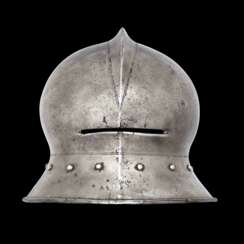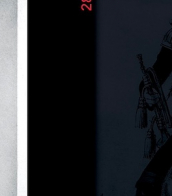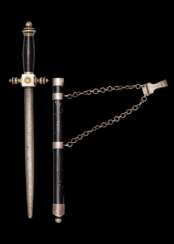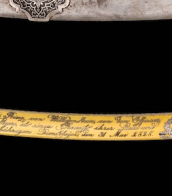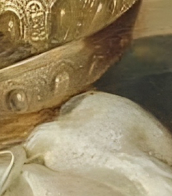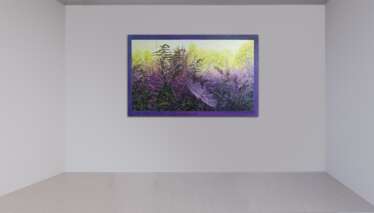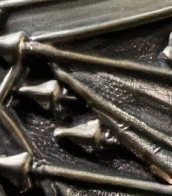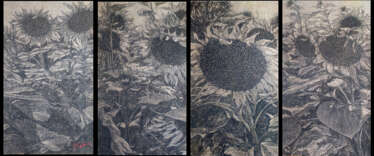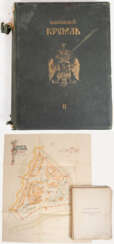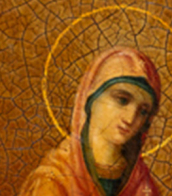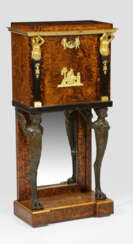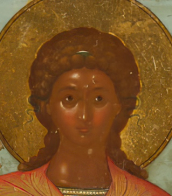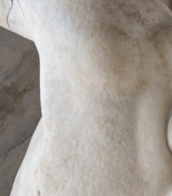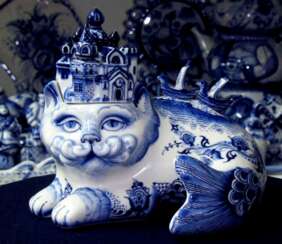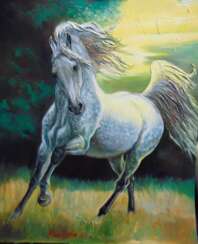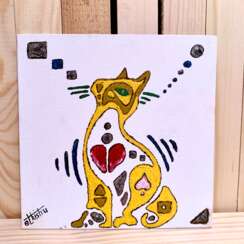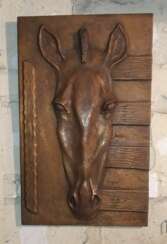103 Items by auctions and galleries:
stiere
Рыба-кот
Sergey Karpukhin (b. 1960) 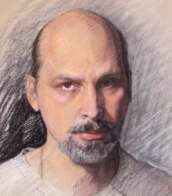 Shop Karpukhin Sergey
Shop Karpukhin Sergey

Sergey Karpukhin
11.05.1960
Russia
Член Союза московских архитекторов, Член Творческого союза художников России, Член Союза кинематографистов России, член Гильдии режиссеров. Сценарист, режиссер, продюсер, художник, фотограф, архитектор.
Первую половину жизни работал, как художник и архитектор, занимался фотографией и философией. Вторую половину, работаю как режиссер и сценарист, не оставляя при этом изобразительного искусства и философии. Окончил художественный факультет Красноярского художественного института, ФПК градостроительства МАРХИ и ВГИК- ВИППК.
НАГРАДЫ:
1991 Первая премия, Философские инновационные игры «Культура и
образование III тысячелетия», г. Москва.
1994 Премия «НИКА» за лучший научно-популярный фильм
1993 года, (совместно с В.М. Кобриным), Россия.
2008 Приз «Лучший телевизионный фильм». II Российский
фестиваль социально значимых телепрограмм и
телефильмов «Герой нашего времени», Россия.
2008 Приз «ФОНДА ДЖОНА Д. И КЭТРИН Т. МАКАРТУРОВ», США.
XIV Международный фестиваль фильмов о правах
человека «СТАЛКЕР».
2008 XIII Международный фестиваль кинофильмов и
телепрограмм «РАДОНЕЖ». Диплом II степени,
Россия.
2015 Приз «Серебряный Витязь». VI Международный
славянский литературный форум «Золотой Витязь»,
Россия.
2016 Приз «Белая голубица», Tesla Global forum,
Сербия.
2017 Гран При в номинации «Научная работа» Международного творческого
конкурса «Гомер», Греция, Афины.
2017 Диплом «За непревзойденную культурную деятельность»
в номинации «Лучшее философское
произведение» Международной литературной премии
им. Нодара Джина, Греция, Афины.
2017 Золотой диплом VIII Международного славянского
литературного форума «Золотой Витязь».

Artist shop
Karpukhin Sergey
Russia
Number of products: 23
Верность короне
Sergey Stroganoff (b. 1982)  Shop Stroganoff Sergey
Shop Stroganoff Sergey

Sergey Stroganoff
23.10.1982
Russia
Я родился 23 октября 1982 года в городе Киржач Владимирской области, где провел свое детство и юность, уже тогда увлекаясь рисованием, посещая художественную школу. Особенно хорошо у меня получаются работы, выполненные карандашом и тушью. Это и положило начало реализации творческого потенциала именно в этом направлении искусства – карандашной анималистической графике. На протяжении многих лет я оттачивал свое мастерство и с 2010 года с удовольствием приступаю к рисованию животных цветными карандашами.
В 2013 году мои работы занимают первое место на XIV международной выставке-конкурсе современного искусства "Российской неделе искусств" в номинации: "Экспериментальная графика. Анималистика". В 2014 году я участвовал в Неделе Искусств в Португалии и в номинации "Академическая графика. Рисунок" и занял второе место. В 2016 мои работы занимают все первых три места на Кубке России по художественному творчеству "Ассамблея искусств" в конкурсе "Графика". В 2017 году получаю первое место в арт-проекте "По следам красной книги". В этом же году становлюсь финалистом международного конкурса "Золотая черепаха".
Мои работы отмечены Российской Академией художеств.
С 2015 года в российских музеях с большим успехом проходит моя первая персональная выставка «Отражения», на которой представлены иллюстрации к басням Эзопа и Лафонтена. Выставка выставлялась в более 7 музеях на территории России.
Премьера второй моей персональной выставки «Посланники мира» состоялась 2017г. в Лондоне.

Artist shop
Stroganoff Sergey
Russia
Number of products: 6
Ангельский бульдожка
Sergey Stroganoff (b. 1982)  Shop Stroganoff Sergey
Shop Stroganoff Sergey

Sergey Stroganoff
23.10.1982
Russia
Я родился 23 октября 1982 года в городе Киржач Владимирской области, где провел свое детство и юность, уже тогда увлекаясь рисованием, посещая художественную школу. Особенно хорошо у меня получаются работы, выполненные карандашом и тушью. Это и положило начало реализации творческого потенциала именно в этом направлении искусства – карандашной анималистической графике. На протяжении многих лет я оттачивал свое мастерство и с 2010 года с удовольствием приступаю к рисованию животных цветными карандашами.
В 2013 году мои работы занимают первое место на XIV международной выставке-конкурсе современного искусства "Российской неделе искусств" в номинации: "Экспериментальная графика. Анималистика". В 2014 году я участвовал в Неделе Искусств в Португалии и в номинации "Академическая графика. Рисунок" и занял второе место. В 2016 мои работы занимают все первых три места на Кубке России по художественному творчеству "Ассамблея искусств" в конкурсе "Графика". В 2017 году получаю первое место в арт-проекте "По следам красной книги". В этом же году становлюсь финалистом международного конкурса "Золотая черепаха".
Мои работы отмечены Российской Академией художеств.
С 2015 года в российских музеях с большим успехом проходит моя первая персональная выставка «Отражения», на которой представлены иллюстрации к басням Эзопа и Лафонтена. Выставка выставлялась в более 7 музеях на территории России.
Премьера второй моей персональной выставки «Посланники мира» состоялась 2017г. в Лондоне.

Artist shop
Stroganoff Sergey
Russia
Number of products: 6
серый конь
Nadezhda Griniko (b. 1973)  Shop Griniko Nadezhda
Shop Griniko Nadezhda

Nadezhda Griniko
22.01.1973
Russia
Вышиваю картины , рисую маслом, акрилом, в смешанной технике ,а так же выполняю коллажи из текстиля и полимерной глины.
Живу на Дальнем Востоке России, в маленькой деревушке в Амурской области. Творчество - моя отдушина , в свои работы я вкладываю энергию добра , позитива и радости. Люблю природу, животный мир, с особой любовью изображаю лошадей, восхищаюсь красотой и грацией этих благородных созданий.

Artist shop
Griniko Nadezhda
Russia
Number of products: 53
Скульптура бюст лошади
Bayarma Dashiyeva (b. 1973)  Shop Dashiyeva Bayarma
Shop Dashiyeva Bayarma

Bayarma Dashiyeva
19.02.1973
Russia
Самодеятельный художник, скульптор анималист. Любимая тема - лошади. Также работаю маслом акварелью, резьбой по дереву. Принимаю индивидуальные заказы картин животных, скульптуры и барельеф животных

Artist shop
Dashiyeva Bayarma
Russia
Number of products: 2
Недорогая картина. Интерьер. Собака. Человек и собака.
Olga Chernova (b. 2007)  Shop Chernova Olga
Shop Chernova Olga
Olga Chernova
06.07.2007
Russia
Доброго времени суток, я художник! И моя цель принести в ваш дом красоту и уют. Большинство моих картин созданы именно для интерьера детской комнаты. В своих работах я отражаю всю красоту мира. Они очень привлекают детей, потому что эта особая техника очень близка им. Я пишу работы в разных жанрах, но все картины объединяет одна тема - счастье детей и мир их глазами. Для кого то мои работы не понятны и вселяются непонимание, но их не стоит воспринимать близко, ведь дети никогда не берут картины во что то с очень глубоким смыслом. Если быть проще, то можно понять все мои работы! Удачных покупок в моём мини магазинчике!
Artist shop
Chernova Olga
Russia
Number of products: 14
Космический сторож
Kateryna Kish (b. 1989)  Shop Kish Kateryna
Shop Kish Kateryna

Kateryna Kish
24.05.1989
Ukraine
Etkish’u - это уникальная коллаборация двоих, Романа и Екатерины.
Роман всегда рисовал уникальную графику, схожей на которую в мире нет. Катя всегда любила краски. Идея пробовать работать вместе пришла спонтанно, когда однажды Роман увидел, как Катя разрисовывает один рисунок.
Все картины написаны двумя, эскизы рисует Роман, а масляной краской наполняет их Екатерина. Они друг без друга работать не могут, так как идеи есть только у Романа, а красками владеет Катя.
Все работы уникальны, современное искусство, часто минимализм, фантастика, главная тема: космос.

Artist shop
Kish Kateryna
Ukraine
Number of products: 28
Кошачья нежность
Kateryna Kish (b. 1989)  Shop Kish Kateryna
Shop Kish Kateryna

Kateryna Kish
24.05.1989
Ukraine
Etkish’u - это уникальная коллаборация двоих, Романа и Екатерины.
Роман всегда рисовал уникальную графику, схожей на которую в мире нет. Катя всегда любила краски. Идея пробовать работать вместе пришла спонтанно, когда однажды Роман увидел, как Катя разрисовывает один рисунок.
Все картины написаны двумя, эскизы рисует Роман, а масляной краской наполняет их Екатерина. Они друг без друга работать не могут, так как идеи есть только у Романа, а красками владеет Катя.
Все работы уникальны, современное искусство, часто минимализм, фантастика, главная тема: космос.

Artist shop
Kish Kateryna
Ukraine
Number of products: 28
Девочка в красном сарафане
Tatjana Jansberga (b. 1967)  Shop Jansberga Tatjana
Shop Jansberga Tatjana

Tatjana Jansberga
18.11.1967
Germany
Здравствуйте! В 2003 году, по семейным обстоятельствам, переехала из Риги (Латвия) в Дюссельдорф. Пишу картины на заказ, этим и зарабатываю. Работы находятся в частных собраниях Латвии, Германии, ЮАР
Участвовала на Ярмарке искусств «ArtExpoSPb 2015» Санкт-Петербург.
Участвовала на Ярмарке искусств "Hildener Künstlermarkt" Хилден, Германия, 2016.
Участвовала в выставке "Italian Style" PALAZZO VERSACE, DUBAI 2016.
Участвовала на Ярмарке искусств c "Hildener Künstlermarkt" Хилден, Германия, 2018.

Artist shop
Jansberga Tatjana
Germany
Number of products: 19
Коровка
Andrey Ershov (b. 1966)  Shop Ershov Andrey
Shop Ershov Andrey

Andrey Ershov
08.04.1966
Russia
Родился в 1966 году в республике Марий Эл, в городе Йошкар-Ола. Тягу к живописи почувствовал еще в детстве, много рисовал, позднее познакомился с резьбой по дереву и с 1979-го года занимаюсь этим ремеслом. В 1984-ом году закончил волжское училище №5 по специальности "альфрейные живописные работы". После службы в армии долгое время работал художником-оформителем, далее - реставратором (участвовал в реставрации внутренней отделки посольства Франции в Москве). Занимаюсь резьбой для души, в свободное от работы время.

Artist shop
Ershov Andrey
Russia
Number of products: 3
каурая Kaur
Alexandr Orel (b. 1961)  Shop Orel Alexandr
Shop Orel Alexandr
Alexandr Orel
25.01.1961
Byelorussia
Московский скульптурный комбинат.Композиции из металла и декоративные изделия.Член Союза Художников Росссии с 1991года .Секция:декоративно-прикладное искусство.
Участник многих московских выставок.
Artist shop
Orel Alexandr
Byelorussia
Number of products: 1
